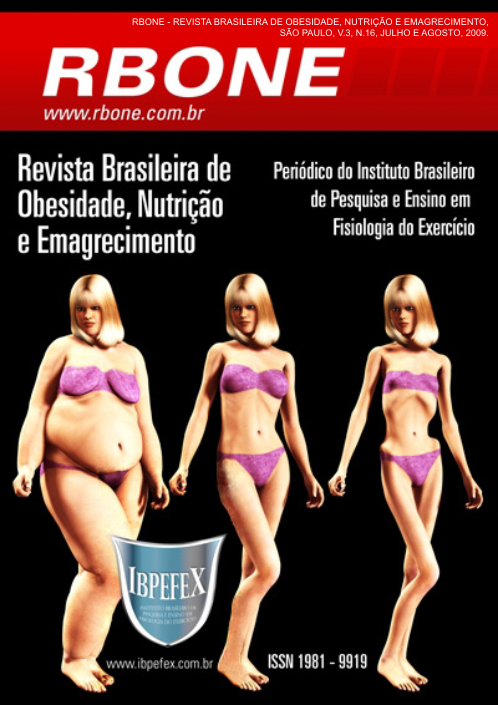Obesity and physical activity: the benefits of high-intensity intermittent exercise in the process of weight loss
Abstract
Exercise together with the rehabilitation food, has been used as the main tool in programs for non-medical weight loss. Some of the likely mechanisms by which exercise can help maintain body and weight loss is the increase in daily energy expenditure and basal metabolic rate, increased muscle mass, increased oxygen consumption and optimizes the process of mobilization and use of fat. Accordingly, high-intensity intermittent exercises have been used as a strategy for the treatment of weight loss. The results presented in this study to review, demonstrate that high-intensity intermittent exercises used in physical training programs aimed at weight loss, can help in a major reduction of body fat in subjects with overweight and obesity. The objective of the study was to evaluate the advantages (or disadvantages) of the method of using high-intensity exercise, through various incentives or breaks, the reduction of body fat and maintenance of body composition. The method has advantages at the implementation and, mainly, in the post office, which already has higher levels of rest metabolic rate and EPOC for a period of time compared with the continuous training of low intensity. This suggests that the model of training with sprints of high intensity intervals produces a higher total energy expenditure (during the execution and return to the levels of rest), and this is crucial when we refer to intentional imbalance of energy balance.
References
- American College Of Sports Medicine. ACSM stand position on the appropriate intervention strategies for weight loss and prevention of weight gain for adults. Medicine Science Sports Exercise. Vol. 33. 2001. p. 2145-2156.
- Darling, J.L.; Linderman, J.K.; Laubach, L.L. Energy expenditure of continuous and intermittent exercise in college-aged males. Journal of Exercise Physiology. Vol. 4. Num. 8. 2005. p. 1-8.
- Eguchi, R.; Cheik, N.C.; Oyama, L.M.; Nascimento, C.M.O.; Mello, M.T., Tufik, S.; Dâmaso, A. Efeitos do exercício crônico sobre a concentração circulante de leptina e grelina em ratos com obesidade induzida por dieta. Revista Brasileira de Medicina do Esporte, Vol.14. Num. 3. Mai/Jun, 2008. p.182-187.
- Fernandez, A.C.; Mello, M.T.; Tufik, S.; Castro, P.M.; Fisberg, M. Influência do treinamento aeróbio e anaeróbio na massa de gordura corporal de adolescentes obesos. Revista Brasileira de Medicina do Esporte. Vol. 10. Num. 3. Mai/Jun, 2004. p. 152-158.
- Jakicic, J.M. The role of physical activity in prevention and treatment of weight gain in adults. Journal of Nutrition, supl. Vol. 132. Num. 12. 2002. p. 3826S-3829S.
- Kinra, S.; Nelder, R.P.; Lewendon, G.J. Deprivation and childhood obesity: a cross sectional study of 20.973 children in Plymouth, United Kingdom. Journal of Epidemiology and Community Health. Vol. 54. Num. 6. 2000. P. 456–460.
- Lanforgia, J.; Withers, R.T.; Shipp, N.J.; Gore, C.J. Comparison of energy expenditure elevations after submaximal and supramaximal running. Journal Applied of Physiology. Vol. 82. Num. 2. 1987. p. 661-666.
- Liberali, R. Metodologia Científica Prática: um saber-fazer competente da saúde à educação. Florianópolis: (s.n.), 2008.
- Mcardle, W.D.; Katch, F.I.; Katch, V.L. Fisiologia do exercício: energia, nutrição e desempenho humano. 4.ed. Rio de Janeiro: Guanabara Koogan, 1998.
- Moreira, M.M.; Souza, H.P.C.; Schwingel, P.A.; Sá, C.K.C. Efeitos do exercício aeróbico e anaeróbico em variáveis de risco cardíaco em adultos com sobrepeso. Arquivos Bras Cardio-logia. Vol. 91. Num. 4. 2008. p. 219-226.
- Oliveira, A.M.A.; Cerqueira, E.M.M.; Souza, J.S.; Oliveira, A.C. Sobrepeso e Obesidade Infantil: Influência de Fatores Biológicos e Ambientais em Feira de Santana, BA. Arquivos Brasileiro Endocrinologia e Metabologia. Vol. 47. Num. 2. 2003. p.144-150.
- Powers, S.K.; Howley, E.T. Fisiologia do exercício. Teoria e aplicação ao condicionamento e ao desempenho. 3. ed., São Paulo: Manole, 2000.
- Rocha, M. L. Aspectos Diversos da Medicina do Exercício. Rio de Janeiro: Revinter, 2004.
- Romijin, J.A.; Coyle, E.; Sidossis, L.; Gastaldelli; Horowitz, J.F.; Endert, E.; Wolfe, R.R. Regulation of endogenous fat and carbohydrate metabolism in relation to exercise duration and intensity. American Journal of Phys. Vol. 265. 1983. p. E380-E391.
- Sabia, R.V.; Santos, J.E.S.; Ribeiro, R.P.P. Efeito da atividade física associada à orientação alimentar em adolescentes obesos: comparação entre o exercício aeróbio e anaeróbio. Revista Brasileira de Medicina do Esporte. Vol. 10. Num. 5. 2004. p. 349-355.
- Silva, M.S. Efeitos do treinamento intervalado na redução da gordura corporal em mulheres adultas. Revista Digital. Buenos Aires, ano 10, Num. 70. Março, 2004.
- Skender, M.L.; e colaboradores. Comparison of 2-year weight loss trends in behavioral treatments of obesity: diet, exercise, and combination interventions. J Am Diet Assoc. Vol. 96. 1996. p. 342-346.
- Volkov, N. I. Teoria e prática do treinamento intervalado no esporte. Campinas: Multiesportes, 2002.
- Whatley, J.E.; Poehlman, E.T. Obesity and exercise. In: Blackburn, G.L.; Kandres, B.S.; editors. Obesity: path physiology and treatment. New York: Chapman & Hall, 1994.
- Wilmore, J.H.; Costill, D.L. Fisiologia do Esporte e do Exercício. 2.ed., São Paulo: Manole, 2003.
Authors who publish in this journal agree to the following terms:
- Authors retain the copyright and grant the journal the right of first publication, with work simultaneously licensed under the Creative Commons Attribution License BY-NC which allows the sharing of the work with acknowledgment of the authorship of the work and initial publication in this journal.
- Authors are authorized to enter into additional contracts separately for non-exclusive distribution of the version of the work published in this journal (eg, publishing in institutional repository or book chapter), with acknowledgment of authorship and initial publication in this journal.
- Authors are allowed and encouraged to post and distribute their work online (eg, in institutional repositories or on their personal page) at any point before or during the editorial process, as this can bring about productive change as well as increase impact and impact. citation of published work (See The Effect of Free Access).






